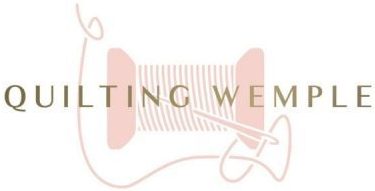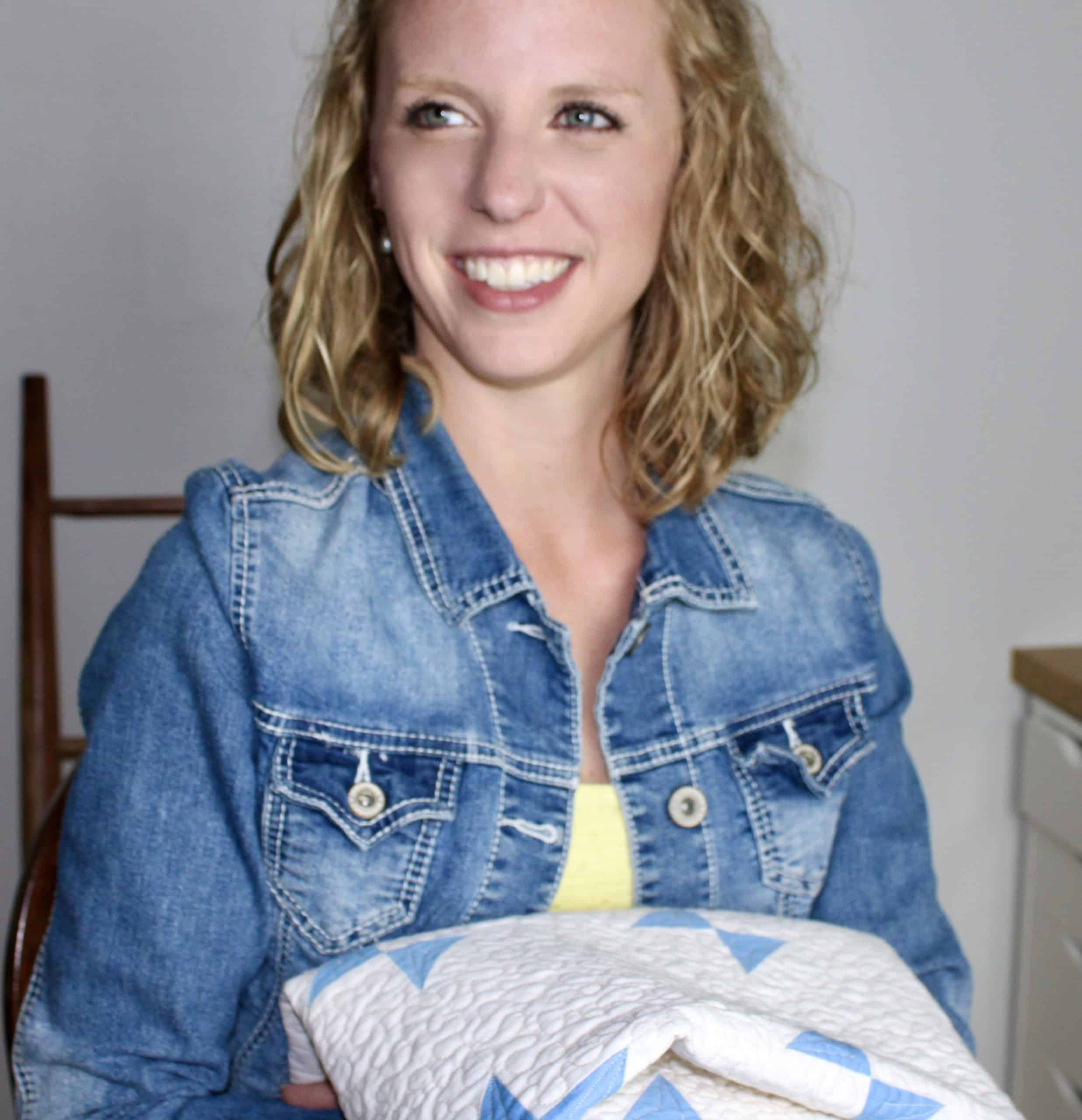Yup here we go again, if I’m counting right, we’re up to about 3 million different ways to bind a quilt.
Sometimes it feels like there are more tutorials out there to bind a quilt then there are patterns to make the actual quilt tops!
Okay, maybe not that many, but it sure feels pretty close.
So which one have we managed to leave out until now? Flange binding!
Flange binding is a fun variation on a French double fold binding and by only adding one extra seam in your quilt binding, you can add a fun pop of color to an otherwise traditional finish.

What is a flange on a quilt
Broadly put, a flange on a quilt is a thin insert of fabric that is folded in half length-wise and slipped between layers of a seam.
The folded finish of the flanged edge is exposed on the quilt top and the raw edges are secured by the seam.
This technique gives your quilt a 3D quality as the flange essentially floats off the surface of the quilt.
While a flange can really be used anywhere on a quilt, one of the more common places to find them is in the binding.
What is flanged binding
A flange binding is a pieced binding strip that folds two fabrics unevenly showing both fabrics in the finished binding.
Flanged binding is slightly different than the traditional application of adding a flange.
In traditional flange techniques you are slipping a third piece of fabric between the seams, in a binding application this would mean you slipped a piece of fabric underneath the fold of the binding to create an additional pop of color that gives a trim effect to your binding.
By doing this manually, you have to take a lot of time and effort to get the small strip of fabric to show consistently across the entire quilt. When the exposed area of the flange is only about 1/8″ wide, this can quickly become a tedious task.
In modern flange binding, we can skip the added pain of adding a flange traditionally and fake it by actually building it in to our binding strip.
It saves you a lot of time and work by taking the extra steps out but gives you the same added detail. Win-win all around!
Faux Flange Binding vs. Faux Piping Binding
This technique goes by a few different names:
- Flange Binding
- Faux Flange Binding
- Faux Piping Binding
As best I can tell, they are all interchangeable.
It definitely threw me for a loop when I read “Flanged binding” and “Faux flanged binding” and got the exact same tutorial.
What I’ve realized is that all of the tutorials of this technique are actually all Faux Flange Binding techniques. The “Faux” comes in because we are bypassing using a traditional flange technique and basically using a hack to get the same look with less effort.
From what I can tell, at some point it became such a popular way to achieve the look that it eventually just dropped the “Faux” in the name.
And simply became the only way you’d ever sew a flanged binding on a quilt.
Why go through all the extra steps and hassle doing it the traditional way when you get the same look in a fraction of the the time and effort?
Flange binding tool

Before we get into the tutorial, how do we make this simplified process even easier? And are there any notions worth our time and money?
I took a good look around to see if there were any good notions out there for helping make and attach a flange binding, and the simple answer I came up with?
There are tools out there, but in my opinion, none worth the investment.
The best tool I could find was a ruler with specialty lines on it so you didn’t have to remember how wide to cut the strips for the binding.
But the standard widths to cut the binding are just normal widths available on any quilting ruler.
Where the ruler itself was over $25 and only contained two lines on it, I didn’t feel like I personally would ever make enough flanged binding for it to be worth the money and storage space it would take up.
There is something to be said about not having to look up the strip widths every time though, so what may not be worth the money to me, might be pure gold to you.
How to make a flanged binding
Materials
- Quilt prepared for binding
- Main binding fabric
- Flange accent binding fabric
- Sewing machine
- Binding clips
Cutting Measurements
- Main binding fabric – cut widths of 1 1/2”
- Accent flange fabric – cut strip widths of 1 3/4”
Make individual binding strips

The process for making flange binding is very similar to traditional double folded binding.
Begin by piecing together your main binding strips and accent flange strips independent of each other so it looks like you have two rolls of binding.
When you piece together your strips, be sure to use a diagonal seam to distribute the fabric bulk around the seams evenly.
For more details on how to make this seam, be sure to check out our tutorial on how to make quilt binding.
Related posts:
How to Bind a Quilt by Hand
How to Bind a Quilt by Machine
How to Calculate Quilt Binding
Quilt Binding Calculator
Piece the binding

Once both fabric strips are completed, sew the two long strips together along a long edge. You will notice that one side is slightly wider than the other, that is what we are looking for.
Press the seam to the main fabric of the binding – away from your accent flange fabric.
Folding wrong sides together and matching up the raw edges, iron the binding strip in half the long way the full length of the binding strip.

You will notice that the seam between the two fabrics does not sit exactly where the fold occurs between the two fabrics.
This should mean that you should see a small strip of the accent fabric lining the edge of the binding the full length of the strip.
This will be your faux flange binding!
Attach binding to quilt

This process is going to be identical to most other quilt binding methods you likely have used in the past.
Place your quilt top down so the backing is up and face the binding with the main fabric face down on top of the backing.
Starting at least 12” away from a corner, pin the binding to the edge of the quilt so the raw edges are matched up.
Although you can certainly pin everything ahead of time, I tend to fly by the seat of my pants when it comes to binding. I usually pin a starting point and just start sewing.
Starting off the edge of the binding, back stitch and sew a 1/4” all the way down the edge of the quilt to attach the binding. Be sure to match up the raw edges as you go.
When you get close to the corner, stop a bit early and just leave the quilt in the sewing machine with the needle down where you stopped.
Round the Corner

Before we get much further we’ll want to give ourselves a place to stop the sewing machine for a perfect mitered corner.
Using a ruler and marking pen, make a mark 1/4″ in from the very corner of your quilt.
Finish attaching your binding down the edge of the quilt. When you hit that mark, turn the quilt and sew off the corner of the quilt. Break your thread and pull it out of the machine.
Fold the binding a 45deg angle, so it starts to run away from the next edge of the quilt.
Then make a second fold on the dotted line above to direct the binding back toward the next side. The folded edge should line up perfectly with the raw edge of the side we just finished attaching.
No fancy corner stitching this time, starting right off the edge of the quilt start attaching the next side, backstitching to secure the corner.
Sew all the way down the next side and repeat the process when you get to the next corner.
When you get all the way back to the point where you started, stop atleast 12 inches before your starting point.
How to join flange binding

Lay the remaining binding over the loose tail from the starting point of the binding.
At any point where they overlap, mark a point on both layers so the marks lay directly on top of each other.
Lay the two strips on top of each other so they are perpendicular to each other and the two marks meet exactly in the lower right hand corner.
Mark the diagonal seam just like we did at the beginning to combine individual strips, sew the seam, and trim the excess beyond the seam allowance.
Note: It’s not uncommon to accidentally twist the two ends by accident. Test the seam before sewing it to make sure your ends will lay flat and not twist.
Once joined, finish sewing the binding to the quilt, back stitching where you start and stop to secure.
How to finish a flange binding

When using a flange binding, you will want to machine bind the last seam.
Once secured to the back of the quilt, carefully wrap the binding around to the front of the quilt.
You should see your beautiful flange in the binding!
Using binding clips (they make a huge difference) temporarily secure the flange binding around the front of the quilt at least 3-4 clips worth.
Using your walking foot, machine bind the quilt by stitching in the ditch in the seam where your flange fabric meets your binding fabric.
Stitching in the ditch will cause your stitches to fall between the fabrics becoming almost invisible, and define the line between your main binding fabric and your flange.
Sew all the way around the quilt folding in the corner to create a finished mitered corner.
Once you’ve made it all the way around the quilt you are officially done!
Your binding is nice and secure to the edge of the quilt while your flanged binding edge is free to move about as a 3D aspect of your quilt!

Wide flange binding – Altering the Measurements
Maybe you want a little more sass to your flange and want the accent color a little bit thicker?
To create a wide flange binding, simply increase the width of the flange binding fabric when you make your binding strips.
Do not change the width of the main color binding fabric.
Increasing the flange binding fabric width will give you a thicker accent flange while keeping your actual binding color the same width.
If you increase both, the proportions between the two will remain the same and you will just have a thicker overall binding.
Don’t Forget Your Free Quilt Pattern!
If you got something out of this tutorial and want more of them in the future, be sure to sign up for my email updates below so you never miss a post.
Not to mention you’ll get a copy of my free quilt pattern Vichy as a thanks for joining!








0 Comments